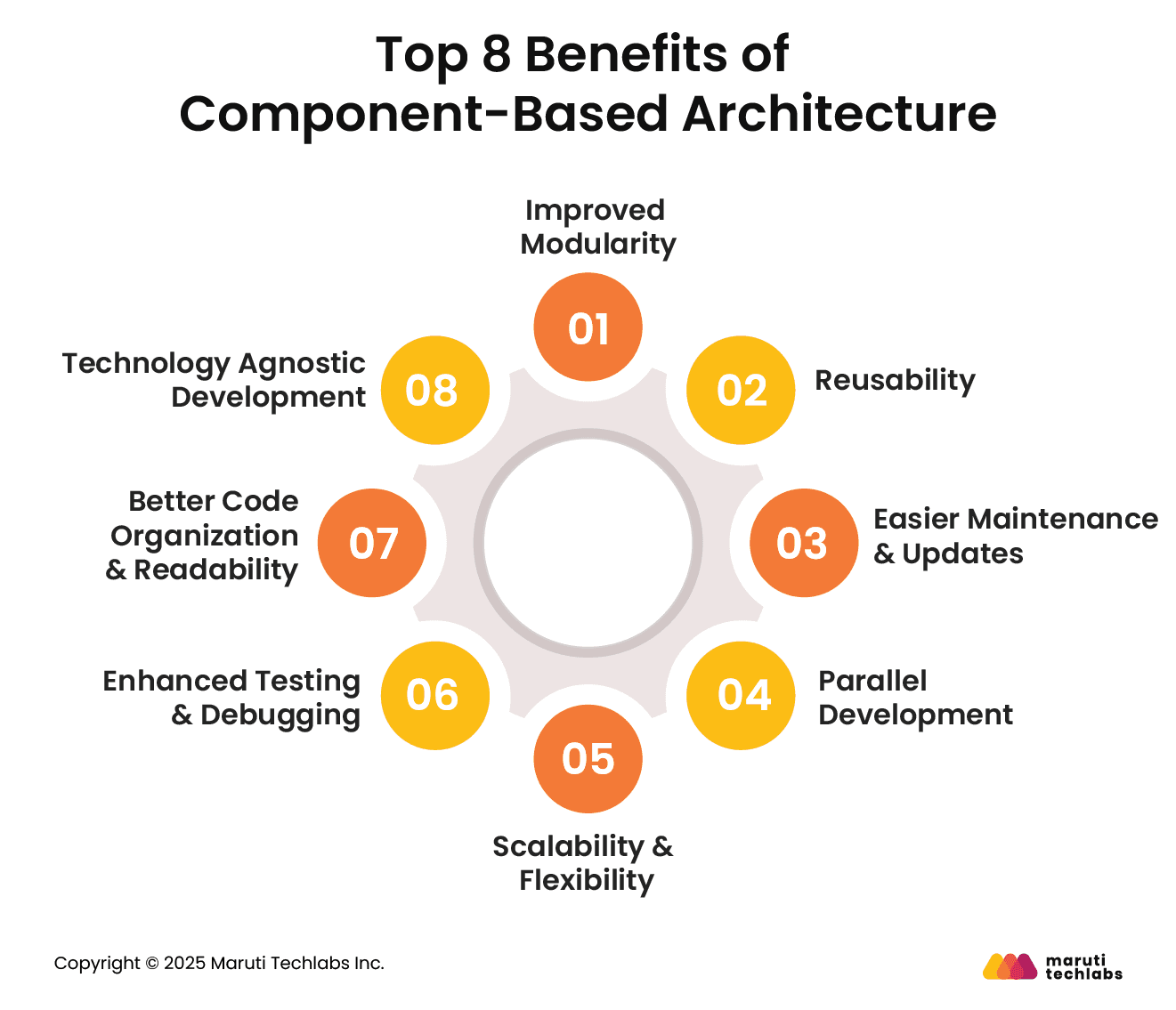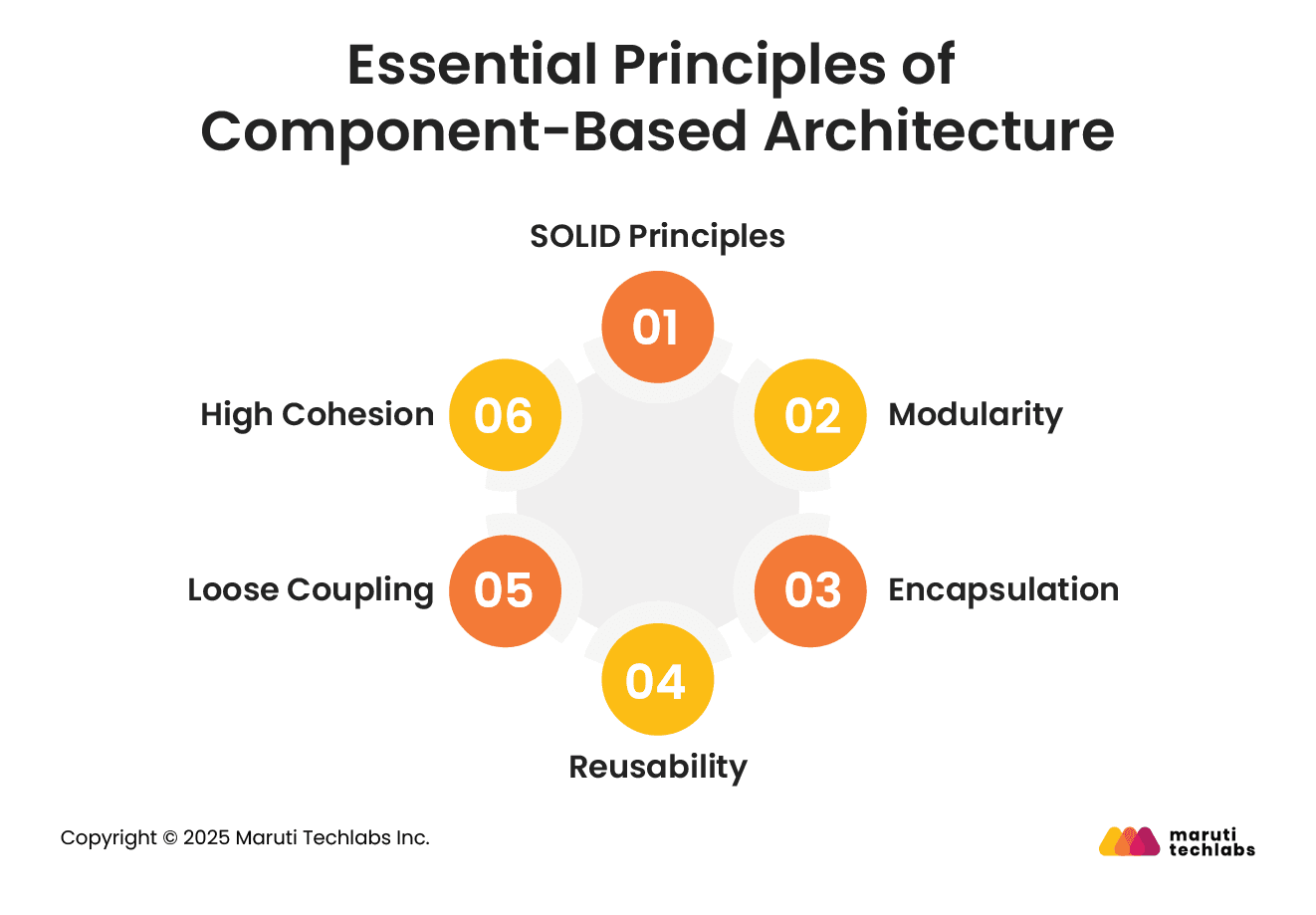Component-Based Architecture: Principles, Benefits & Examples
 Maruti Techlabs
Maruti Techlabs
Introduction
Modern software systems are becoming increasingly complex, making scalability, maintainability, and rapid development more challenging to achieve. Component-Based Architecture (CBA) addresses these challenges by breaking down applications into independent, reusable, and loosely coupled components.
Each component encapsulates specific functionality and communicates with others through well-defined interfaces, enabling developers to build robust systems like assembling building blocks.
This architectural style has gained significant traction in modern development, particularly in microservices, front-end frameworks such as React or Angular, and even enterprise-grade backend systems.
Its key strengths lie in code reusability, easier testing, and the ability to scale teams by letting them work on separate components simultaneously. By isolating changes to individual parts, CBA also reduces technical debt and accelerates the delivery of features.
In this article, we delve into what component-based architecture is, its design principles, and provide real-world examples. Additionally, it provides actionable insights for the effective implementation of your projects.
Whether you’re building a modular UI library or designing a distributed backend, understanding how to leverage component-based architecture can transform the way your software evolves.
What is Component-Based Architecture?
A Component-Based Architecture (CBA) is a software design approach where applications are built by assembling independent, reusable, and self-contained components that communicate through defined interfaces, promoting modularity, scalability, and maintainability.
CBA enables faster development, easier testing, and seamless scalability by allowing teams to develop, deploy, and update components independently. It also improves code reuse and simplifies system maintenance in complex, evolving software projects.
Top 8 Benefits of Component-Based Architecture
Component-Based Architecture (CBA) offers significant advantages for modern software development. By focusing on modularity and reusability, it enhances system flexibility, accelerates delivery, and simplifies maintenance in complex and evolving applications.

1. Improved Modularity
Breaking systems into self-contained components enables teams to focus on specific functionality. This modularity makes it easier to understand, develop, and modify parts of the system without disrupting the entire application.
2. Reusability
Well-designed components can be reused across multiple projects or application modules. This reduces development time, promotes consistency in user experience, and lowers costs by avoiding duplicate effort for similar functionality.
3. Easier Maintenance & Updates
Since components are loosely coupled, updates or bug fixes can be applied to individual components without impacting others. This isolation reduces downtime and makes systems more resilient to change.
4. Parallel Development
Teams can work on different components simultaneously, thereby improving productivity and accelerating project delivery. Clear interfaces allow seamless integration, even when components are developed independently.
5. Scalability & Flexibility
CBA supports scaling at the component level. You can deploy and scale only the components under heavy load, rather than scaling the entire application, which leads to more efficient resource utilization.
6. Enhanced Testing & Debugging
Testing individual components in isolation simplifies debugging and improves reliability. Unit and integration tests can focus on specific functionality, leading to faster detection and resolution of issues.
7. Better Code Organization & Readability
Organizing code into logical, reusable units enhances readability and maintainability. Developers can quickly understand system structure and onboard onto projects faster, even in large, distributed teams.
8. Technology Agnostic Development
In backend microservices or cloud systems, components can even be developed using different languages or frameworks, enabling teams to choose the best tools for each component’s requirements.
Essential Principles of Component-Based Architecture
Designing robust software with Component-Based Architecture requires adhering to key principles that ensure components are modular, reusable, and maintainable. Below are essential guidelines for effective component-based design.

1. SOLID Principles
Applying SOLID principles ensures components are well-structured and maintainable. Single Responsibility keeps components focused, Open/Closed encourages extensibility, and Interface Segregation ensures clean APIs, making the system easier to evolve without breaking existing functionality.
2. Modularity
CBA promotes modularity by dividing applications into small, self-contained units. This makes the system more flexible, as developers can replace, update, or scale individual modules without affecting the entire codebase. It also supports parallel development across teams.
3. Encapsulation
Each component hides its internal logic and exposes only necessary interfaces. This abstraction reduces dependencies between components, minimizes side effects, and protects against unintended interactions, which is crucial for maintaining stability in large systems.
4. Reusability
Reusable components save development time and improve consistency. Well-designed components can be used across multiple projects or within different parts of the same system, fostering standardization and reducing duplication of effort.
5. Loose Coupling
Components should interact with minimal dependencies to avoid ripple effects from changes. Loose coupling enables independent deployment and testing, making systems more resilient and easier to scale.
6. High Cohesion
A component’s internal elements should work closely together toward a specific purpose. High cohesion improves maintainability and ensures that each component is understandable, testable, and functionally complete.
Top 8 Examples of Component-Based Architecture
Component-based architecture is widely adopted across modern software stacks. From frontend frameworks to backend systems and cloud-native platforms, here are real-world examples showing how components drive modularity, scalability, and maintainability in diverse environments.
Read More:- Implementing Component-Based Architecture in 8 Simple Steps
Subscribe to my newsletter
Read articles from Maruti Techlabs directly inside your inbox. Subscribe to the newsletter, and don't miss out.
Written by

Maruti Techlabs
Maruti Techlabs
Maruti Techlabs is an award-winning product strategy, design, and development partner. We bring the strategic value of product development consultants, the technical expertise of product engineers, data and systems architects combined with the UX-first approach to early-stage startups and established ventures. With a rich & varied experience of 13+ years in software development & a global clientele, we do everything from materializing your ideas through rapid application development & improving processes via RPA and AI to streamlining customer support via chatbots. We believe that the best business comes from long-term relationships, and it’s why we strive to build long-term partnerships with our customers. Our team of highly skilled & experienced developers, designers, and engineers understand the market's pulse & specific business needs to provide custom product development solutions. Service Offerings: Product Development Rapid Prototyping Low Code/No Code Development MVP Development Data Engineering Computer Vision Machine Learning Natural Language Processing DevOps Cloud Application Chatbot Development Robotic Process Automation Business Intelligence Data Analytics Quality Engineering Awards & Recognition: Great Place to Work Top B2B IT Company - By Clutch Best Company to Work With - By GoodFirms India’s Growth Champion - Statista & Economic Times Most Reviewed AI Partners - By The Manifest We provide a people-centric work environment that enables our employees to: Enhance their professional & personal growth Use the latest technologies to make a positive impact Experience collaborative innovation with a focus on diversity & work-life balance Discover global opportunities to work & learn with industry leaders Our mission is to help our clients build future-proof and intuitive digital products while guiding them with the best processes & practices that help them undergo a successful digital transformation and scale sustainably.